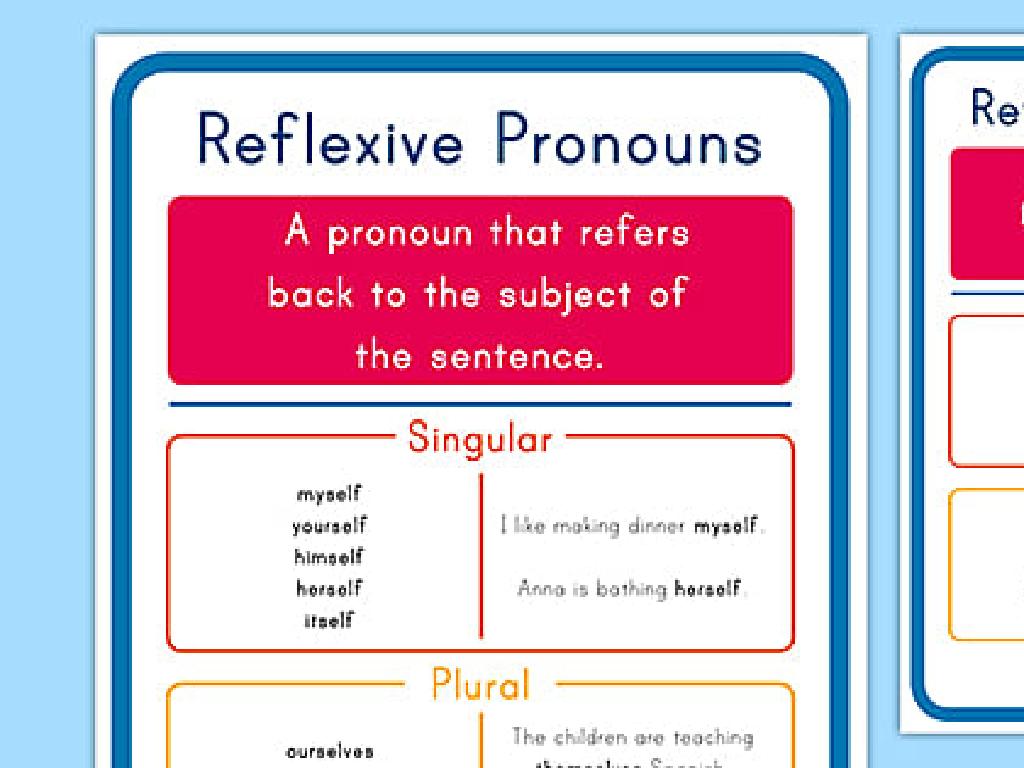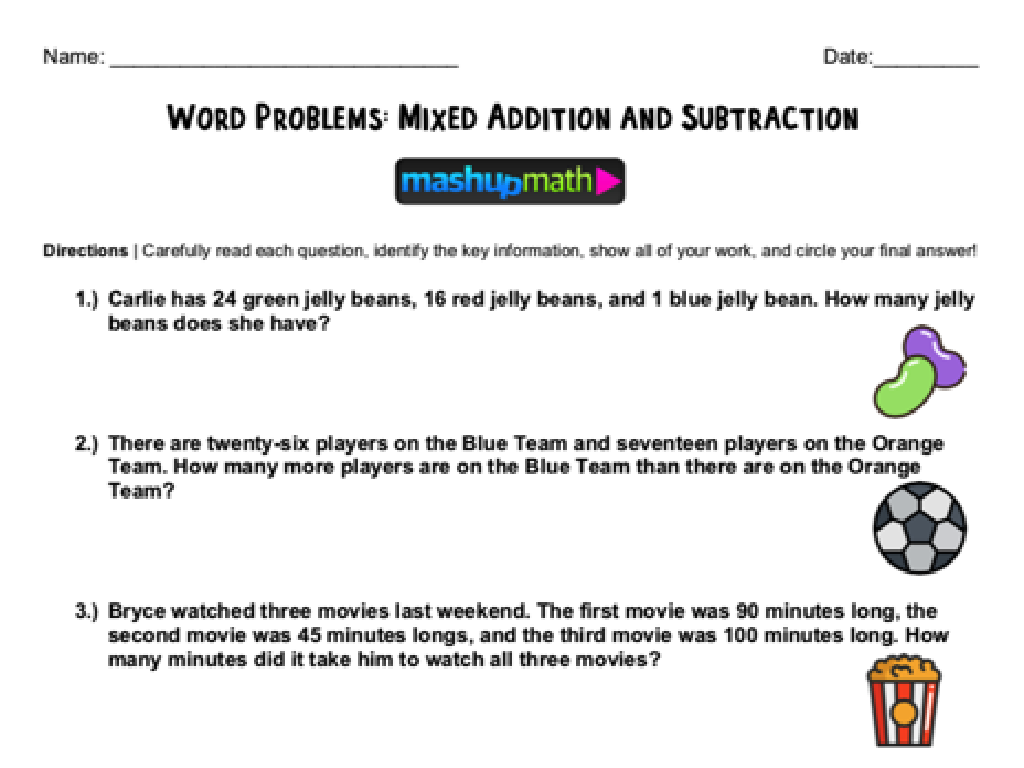Identify Gerunds And Their Functions
Subject: Language arts
Grade: Eighth grade
Topic: Verb Tense And Mood
Please LOG IN to download the presentation. Access is available to registered users only.
View More Content
Understanding Gerunds in English
– What is a gerund?
– A gerund is a verb ending in -ing that functions as a noun.
– Gerunds as subjects
– Example: ‘Swimming is fun.’ (Swimming is the subject of the sentence)
– Gerunds as objects
– Example: ‘They enjoy swimming.’ (Swimming is the object of ‘enjoy’)
– Gerunds after prepositions
– Example: ‘They talked about swimming.’ (Swimming is the object of the preposition ‘about’)
|
This slide introduces the concept of gerunds to the students. A gerund is a verb form that ends in -ing and acts as a noun in a sentence. It can perform the function of a subject, direct object, subject complement, or object of a preposition. Provide examples for each case to illustrate how gerunds are used in different contexts. Encourage students to create their own sentences using gerunds in various functions. This understanding will help them in identifying and using gerunds correctly, which is an essential part of mastering verb tense and mood in English language arts.
Understanding Gerunds
– Define a gerund
– A gerund is a verb form used as a noun.
– Gerunds end with -ing
– Look for verbs ending in -ing in sentences.
– Example: ‘Swimming is fun.’
– ‘Swimming’ is the gerund, acting as a subject.
– Identify gerund and its role
– ‘Swimming’ functions as the subject of the sentence.
|
Introduce the concept of gerunds to students by defining them as verbs that end in -ing and function as nouns within a sentence. Use clear examples to illustrate how gerunds can act as subjects, objects, or complements, just like nouns. In the example ‘Swimming is fun,’ point out that ‘swimming’ is the gerund and it is serving as the subject of the sentence. Encourage students to find gerunds in sentences and determine their function. This will help them understand how gerunds fit into the larger context of verb tense and mood, and enhance their grammatical skills.
Gerunds as Subjects
– Gerunds as sentence subjects
– A gerund is a verb ending in -ing used as a noun
– Example: ‘Running is my favorite hobby.’
– ‘Running’ functions as the subject of the sentence
– Activity: Find the gerund
– Look at sentences and spot the -ing word acting as a noun
|
This slide introduces the concept of gerunds when they function as the subject of a sentence. A gerund is a verb form that ends in -ing and acts as a noun. For example, in the sentence ‘Running is my favorite hobby,’ ‘running’ is the gerund and is the subject of the sentence. The class activity will involve students identifying gerunds within provided sentences. Teachers should prepare sentences with clear gerunds acting as subjects to facilitate understanding. Encourage students to explain why the identified gerund is the subject and to come up with additional examples. This activity helps reinforce the concept and allows students to apply their knowledge practically.
Gerunds as Objects
– Gerunds can be verb objects
– A gerund is a verb ending in -ing used as a noun
– Example: ‘I enjoy reading.’
– In the sentence, ‘reading’ is what is enjoyed
– ‘Reading’ is the object of ‘enjoy’
– It receives the action of the verb ‘enjoy’
|
This slide focuses on the role of gerunds when they function as objects in a sentence. A gerund, which always ends in -ing, is a verb form that acts as a noun. In the example ‘I enjoy reading,’ the word ‘reading’ is a gerund and serves as the object of the verb ‘enjoy.’ It’s what the subject of the sentence enjoys doing. When teaching this concept, emphasize that gerunds can be used in various functions, but here the focus is on their role as objects. Provide additional examples and encourage students to create sentences using gerunds as objects to reinforce their understanding.
Gerunds after Prepositions
– Gerunds follow prepositions
– A gerund is a verb ending in -ing used as a noun
– Example: ‘interested in learning’
– ‘She is interested in learning French.’ shows ‘learning’ as an activity of interest
– ‘In’ links to ‘learning’
– The preposition ‘in’ shows the relationship with the gerund, indicating involvement
– Understanding ‘in’ and ‘learning’
– Analyze how ‘in’ sets the context for the gerund, making it the focus of interest
|
This slide aims to teach students how gerunds, which are verbs ending in -ing that function as nouns, often follow prepositions in a sentence. Using the example ‘She is interested in learning French,’ we can illustrate how the preposition ‘in’ is used to link the verb ‘learning’ to the rest of the sentence, showing the subject’s interest in the activity. It’s crucial for students to recognize that prepositions like ‘in’ establish a relationship between the gerund and the other elements of the sentence. Encourage students to find more examples of gerunds following prepositions to reinforce their understanding.
Gerunds in Compound Nouns
– Gerunds in compound structures
– Example: ‘a swimming pool’
‘swimming’ is a gerund describing the pool
– Identify the gerund
In ‘a swimming pool’, ‘swimming’ is the gerund
– Understand its modifying role
Gerunds can describe what kind of thing a noun is
|
This slide focuses on the role of gerunds within compound nouns. A gerund is a verb form that functions as a noun. In the context of compound nouns, gerunds modify the noun by describing a particular aspect or purpose. For example, in ‘a swimming pool,’ the gerund ‘swimming’ describes the type of pool. Encourage students to identify the gerund in compound nouns and discuss how it changes the meaning of the noun. Have them practice by finding other examples of compound nouns with gerunds and explaining the relationship between the gerund and the noun. This will help them understand how gerunds function and enhance their ability to analyze sentence structure.
Avoiding Common Mistakes with Gerunds
– Gerunds vs. Present Participles
– Gerunds act like nouns, while participles describe verbs.
– Both end with -ing
– Different functions in sentences
– Gerunds serve as subjects or objects, participles modify nouns.
– Recognize usage in examples
– ‘Running is healthy’ (gerund) vs. ‘The running water’ (participle).
|
This slide aims to clarify the distinction between gerunds and present participles, which is a common area of confusion. Both gerunds and present participles end in -ing, but they serve different purposes in a sentence. Gerunds function as nouns, meaning they can act as the subject, direct object, or object of a preposition. Present participles, on the other hand, act as modifiers for nouns or pronouns and are often used in forming the continuous tenses. Provide clear examples to illustrate the difference, and encourage students to create their own sentences to practice distinguishing between the two. A deeper understanding of this concept will enhance their grammatical accuracy and comprehension.
Class Activity: Gerund Hunt
– Find gerunds in books/articles
– Work in pairs for gerund hunt
– Identify functions of gerunds
– Gerunds act as nouns; look for actions functioning as subjects, objects, or complements.
– Share findings with the class
|
This interactive class activity is designed to help students recognize and understand gerunds in a practical context. Have the students select their favorite books or articles and work in pairs to search for gerunds. They should focus on identifying the gerunds and determining their function in the sentence: whether they’re acting as subjects, direct objects, subjects complements, or objects of prepositions. After the activity, each pair will share examples of gerunds they found and explain their function to the class. This will reinforce their understanding through collaboration and discussion. Possible variations of the activity could include finding gerunds in song lyrics, creating sentences with gerunds, or even writing short paragraphs where gerunds are used in different functions.
Wrapping Up: Gerunds and Their Roles
– Recap: What are gerunds?
– Importance of gerunds in sentences
– Gerunds act as nouns, making sentences more dynamic
– Homework: Craft sentences with gerunds
– Write 10 sentences using gerunds as subjects, objects, etc.
– Get ready for a gerunds quiz next class
|
As we conclude today’s lesson, remind students that gerunds are verbs ending in -ing that function as nouns. Emphasize their importance in adding variety and complexity to writing. For homework, students should write ten sentences, each showcasing a gerund in a different role (subject, direct object, subject complement, object of preposition). This will help reinforce their understanding and prepare them for the upcoming quiz. The quiz will assess their ability to identify gerunds and understand their function within sentences. Provide examples and encourage students to use resources such as their textbooks or online materials to assist with their homework.






